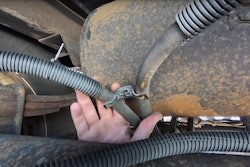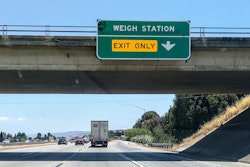According to the Diesel Technology Forum, 53% of all commercial diesel trucks are equipped with the newest generation, clean diesel engine. Those engines deploy emission-strangling equipment that has been standard in commercial trucks on the road since 2010, which help achieve a more than 98% reduction in nitrogen oxides (NOx) and particulate matter.
Joining Jason and Matt this week on CCJ's 10-44 is Diesel Technology Forum Executive Director Allen Schaeffer, and the trio discusses what lies ahead for the diesel engine as emissions regulations get tighter and tighter, and Schaeffer argues that as cleaner-burning engines get more expensive, fleets are more likely to hang on to older equipment.
Contents of this video
00:00 Diesel engines and zero emissions03:24 Emissions control and NOx sensors
04:56 Renewable diesel
08:07 Integrated approach for transportation
08:54 Replacing older trucks
10:51 States’ emissions regulations
13:16 2027 emissions change
This week's 10-44 is brought to you by Chevron Delo 600 ADF ultra low ash diesel engine oil. It's time to kick some ash.
Jason Cannon
What role does the diesel engine play in the path towards zero emissions?
Hey everybody, and welcome to the 10-44, a weekly webisode from the editors here at CCJ. I'm Jason Cannon, and my co-host on the other side is Matt Cole. Diesel emissions have come a long way since the Smokey and the Bandit days. According to the Diesel Technology Forum, 53% of all commercial trucks are equipped with the newest generation clean diesel engine. That technology, which is standard in commercial trucks on the road since 2010, has achieved more than 98% reduction in nitrogen oxides, or NOx, and particulate matter, PM, thanks to the use of selective catalytic reduction systems and advanced particulate matter filters that achieve 98% fewer emissions of fine particles and 98% fewer emissions of oxides of nitrogen, which is a precursor to smog.
Matt Cole
Current generation new diesel trucks are more fuel efficient and emit less than one 60th the emissions of 2000 models. But when the goal is zero emission, almost zero or near zero is not zero.
Jason Cannon
Diesel Technology Forum Executive Director Allen Schaeffer joins us this week to talk about the future of the diesel engine when billions of dollars are being invested into solutions, like electrification and hydrogen, all with the goal of replacing them, despite the emission strides that diesels themselves have made over a generation,
Allen Schaeffer
Dare I say, in 1987, when some of the first Clean Air Act rules were considered, and then, ultimately, began a steady state of adoption of both cleaner engine and fuel standards. At that time, the allowable level of NOx emissions on the class eight truck was, I think, about 10.7 grams per brake horsepower hour. And the most recent adopted rule that EPA published in December of last year puts that number at 0.035, I think it is, grams per brake horsepower hour. So, just in a numerical sense, you get it going from 10 down to less than 0.05, and that's a tremendous change in what emissions come out of a diesel engine over the last, going on now, 30 couple years. We like to think of it as a journey, one of continuous improvement that diesels just continue to get even lower emissions with each passing regulation, and more efficient, as well, over time.
So, for those that are just new to the industry, you're familiar with particular traps and selective catalytic reduction systems. Those were pretty much standard fare on all commercial trucks for the last 12 years, at least, if you've had a newer generation vehicle. 30 years ago, everything was mechanically controlled. Computers weren't part of the whole process. You could adjust fuel injection pressures with a screwdriver. And so, that is where we started, and today we are at this very sophisticated level where we're controlling combustion down to the microsecond and optimizing how the truck runs and the emissions that come out of it. So, it's really been an incredible journey, and we haven't reached the destination yet. We're still more to do.
Matt Cole
As Allen points out, today's cleaner emission trucks are orders of magnitude more efficient and cleaner burning than the trucks of late last century. But now that all the low hanging emission reduction fruit has been picked, how much lower can diesel realistically get?
Allen Schaeffer
That's a question a lot of people are asking, but I think that a couple of things come to mind. I think we are looking now at diesel engines that don't run on diesel fuels at all, and I think the next big chapter in all this will come from a change in the fuels themselves. I think we are certainly reaching the zenith of emissions control in most advanced diesel engines. I think even this most recently adopted rule from EPA, there's a fairly extensive discussion in there about setting the stringency of the standard and some of the background research and things that went into that.
One of the call-outs of concern, really, was that the sensors, those devices that the government relies on to measure emissions both in a test lab setting and even a certification setting, that the sensors themselves are not consistently capable of measuring down to these new extremely low levels of emissions. And that, certainly, more is expected there in terms of commercialization of more sensitive and durable knock sensors in the next five plus years. That gives you an idea of where we are when we're so low in emissions that the sensors, the technology to measure it, is having trouble keeping up.
Jason Cannon
If you take a holistic approach to combustion and emissions, you've basically got two components, the engine itself and the fuel. With so much emphasis on the engine and the role it plays in creating emissions, Allen said there's also been increasing emphasis on fuel type and how a change there, specifically to renewable diesel, would support reduced emissions from the engine.
Allen Schaeffer
There will be a new focus on the fuels that are going into these engines, and that will be an important strategy for the future. And indeed, we're already seeing that at some levels with the growing use of renewable diesel fuel and advanced biodiesel fuels, as well, and particularly in states that have adopted low carbon fuel standards. There are some unknown aspects to it, for sure, but if you look at where things are headed, I mean, the trend is clearly for more investment in this high quality drop-in replacement for diesel fuel. We see that coming from the conventional refining sector and from some of the new energy providers, like Neste, and the traditional biodiesel producers, like the Renewable Energy Group, the Chevron Renewable Energy Group now.
So, we see tons of investment out there in bringing more capacity to produce these advanced renewable biofuels. That industry, the challenge for them will be access to feed stocks that are going to be appropriate for producing the fuels on a consistent stream and cost basis. So, that will be a dynamic that we'll hearing a lot more about in the next decade or so. But for looking at projections and what the government thinks for now, there's certainly a very strong view that more renewable diesel is coming, and I think the Energy Information Administration projected that at the end of 2022, production of renewable diesel would surpass that of conventional biodiesel for the first time.
Matt Cole
Allen says the next decade will be telling as far as which fuels, technologies, and solutions take hold in transportation. But even as hard as the government is currently pushing for electrification, he says there's clearly still a fit and use case for diesel. He tells us more after a word from 10-44 sponsor, Chevron Lubricants
Jason Cannon
Protecting your diesel engine and its aftertreatment system has traditionally been a double-edged sword. The same engine oil that is so essential to protecting your engine's internal parts is also responsible for 90% of the ash that is clogging up your DPF and upping your fuel and maintenance costs. Outdated industry thinking still sees a trade-off between engine and emission system protection, and Chevron was tired of it. So they spent a decade of R&D developing a no compromise formulation. Chevron Lubricants developed a new ultralow ash diesel engine oil that is specifically designed to combat DPF ash clogging.
Delo 600 ADF with OmniMax technology cuts sulfate ash by whopping 60%, which reduces the rate of DPF clogging and extends DPF service life by two and a half times. And just think what you can do with all the MPGs you're going to add from cutting your number of regens. But Delo 600 ADF isn't just about after treatment. It provides complete protection, extending drain intervals by preventing oil breakdown. Before, you had to choose between protecting your engine or your after treatment system, and now you don't. 600 ADF from Delo with OmniMax technology, it's time to kick some ash.
Allen Schaeffer
It's pretty clear, I think. And the government actually just released a report looking at an integrated approach for transportation that spans housing, transportation, energy environmental considerations, and looks at different strategies. And it envisions sustainable internal combustion engines, sustainable fuels equally along with battery electric vehicles in some sectors of the trucking industry and envisions a bigger role for hydrogen in the heavy-duty long haul sector, particularly. So, even as the government looks ahead, and this is the government, by the way, that's really pushing hard for electrification strategies across the board, we see a continued place for renewable fuels and sustainable internal combustion engines.
Jason Cannon
So much emphasis on regulating new truck emissions and the idea that trucking and the diesel engine are all under siege, Allen says, has robbed the industry as a whole of an opportunity to make a near immediate impact on emissions, which is getting old trucks off the road and replacing them with newer ones.
Allen Schaeffer
Research that we did last year shows that 53% of all class three through eight registered trucks on the road are 2011 and newer. So, those are all equipped with SCR and particulate systems achieving very low emissions. So, that means that 47% are not, that they're of an older generation. Some of them have particulate traps, but there's a healthy number that don't have either of those that are still in operation today. And so, when we start looking at where the gross emitters are and where the biggest contributors to pollution and greenhouse gas emissions, I'm thinking that we're not going to find it in the generation of new trucks and fleets that have really accelerated their introduction. We're going to find it more in the existing older technology vehicles that are hanging on. And a lot of these are hanging on in short haul regional applications, and they're operating in urban areas and around communities that are most affected by some of these emissions.
So, I wish we were doing more to address that. Then, I'd feel like we've really being smart about our clean air policy when it comes to different technologies. But I think there's also a recognition within the administration. I think, certainly, manufacturers have communicated this, as well, that internal combustion engines and diesel and natural gas, in particular, these are technologies that are going to be around for a while. That even if you're of the mind that we have to have full scale electrification of all transportation as soon as possible to have even a minor chance of meeting the Paris Climate Agreement, there are realistic people that understand that that kind of change cannot and will not happen overnight.
Matt Cole
Allen said he expects diesel to still be, what he called, the primary mover a decade or more from now thanks in large part to all the infrastructure questions surrounding everything that's trying to replace it. But a patchwork of emission regulations that aren't universal across the U.S., Allen said, will almost certainly change how fleets buy trucks.
Allen Schaeffer
Before, it was one kind of fuel and pretty much all the options. It was a diesel truck, for sure, and then you just figured out whatever you needed to spec the vehicle there. And now, we have this really big change. It's now, also, you have to think about where you're operating, not just what your investment's going to be in five years, but which states are you operating in? Are you operating in any of those 15 states that are thinking about adopting California rules? We have Massachusetts, Oregon, Washington, New York, and New Jersey who have adopted California standards already. And of course, some of all this is hinging on California's waiver being approved by EPA. We'll see how that goes. But if you're a fleet guy, you've got to be thinking about where you're operating, too, because that might alter your strategy and when and how you buy new equipment, as well.
We have some states that are going to be more progressive and require more introduction of zero emission vehicles. Maybe that's going to have some funding associated with it, and maybe that's a place you can link up and get a portion of newer technology vehicles funded by the government. It's hard to know. But those are the factors that I think play in the future. I think the harder part for this particular next chapter in diesel in 2027 is not so much from the technology side of things, but more from the, let's call it, the business and market side.
Which is getting back to a little bit of a point I raised a minute ago, which is juggling both of these worlds. The world we're in now, which is heavily dependent on diesel, and the world that some regulators envision and some manufacturers are going to, which is more zero emission technology. Trying to straddle that world and decide how much investment goes into each is really going to, I think, test the capabilities of business leaders and truck OEMs to sort that out, and what's the right compliance strategies, what's the cost of that? One of the things that the new rule requires, as you're probably aware, is that the emissions control systems be much more durable.
Jason Cannon
Anytime there's a major change in emissions, we've seen widespread pre-buy units from fleets looking to avoid being on that leading edge of first generation technology and avoiding the bugs and the pains that come along with that. A pre-buy is likely, to one degree or another, ahead of the model year 2027 emissions change. But Allen says it's probably not necessary given that the technologies being deployed aren't exactly new or revolutionary.
Allen Schaeffer
Before, we were going from no particulate filter to particulate filter, and then the SCR system. So, I think, clearly, the new vehicles will have both of those things. They're just going to be further refined and improved. So, maybe it's less of a concern in 2027 than it might have been, let's say, in 2006, 2005 when the particulate standard first came into being in '07. There's a lot of factors there, and not the least of which, as I mentioned, is what's your sustainability strategy as a fleet. Do you want your customers asking you for zero emissions technology? Are they happy with greenhouse gas reductions coming from a diesel fleet using renewable diesel fuel? It'll be your opportunity to sell that to them, and that's going to drive, maybe, some of your vehicle choices, replacement cycles, investments in the used market, et cetera in the coming year.
So, a really interesting time. We've just thrown a whole bunch of new variables into the mix. We're not introducing something new, like mechanical emissions controls, like particulate filters, or integrated SCR systems. That introduction and optimization has been done and is underway and will continue, and that will be part of the core strategy going forward, I think. The rule envisions some new things coming into play, things like cylinder deactivation, maybe some waste heat recovery, more things like that. Some of those are newer technologies, for sure, that aren't standard features today. So, I see those as more as incremental change and not the kind of fundamental shift from something without a DPF to something with a DPF.
Jason Cannon
That's it for this week's 10-44. You can read more on CCJdigital.com. As always, you can find the 10-44 each week on CCJ's YouTube channel. And if you've got questions, comments, criticisms, or feedback, please hit us up at [email protected], or give us a call at (404) 491-1380. Until next week, everybody stay safe.











